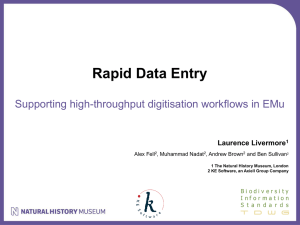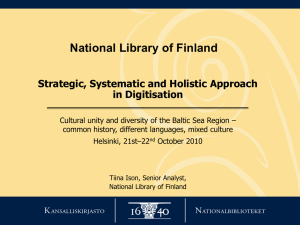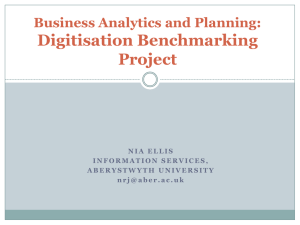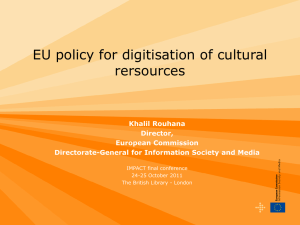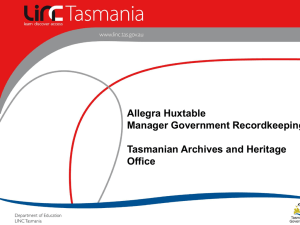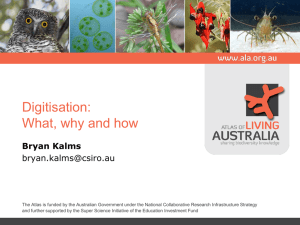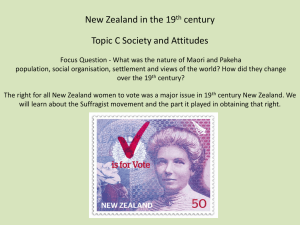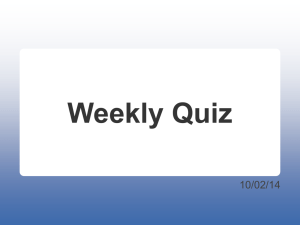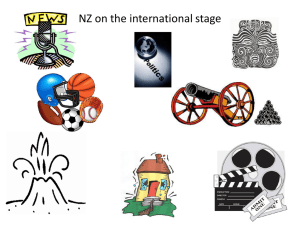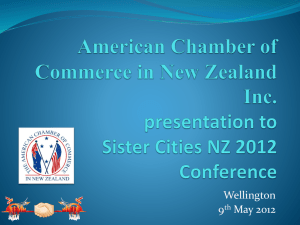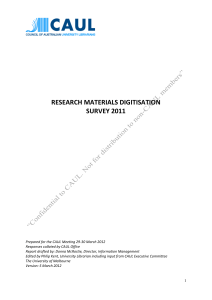Collaborative Digitisation
advertisement
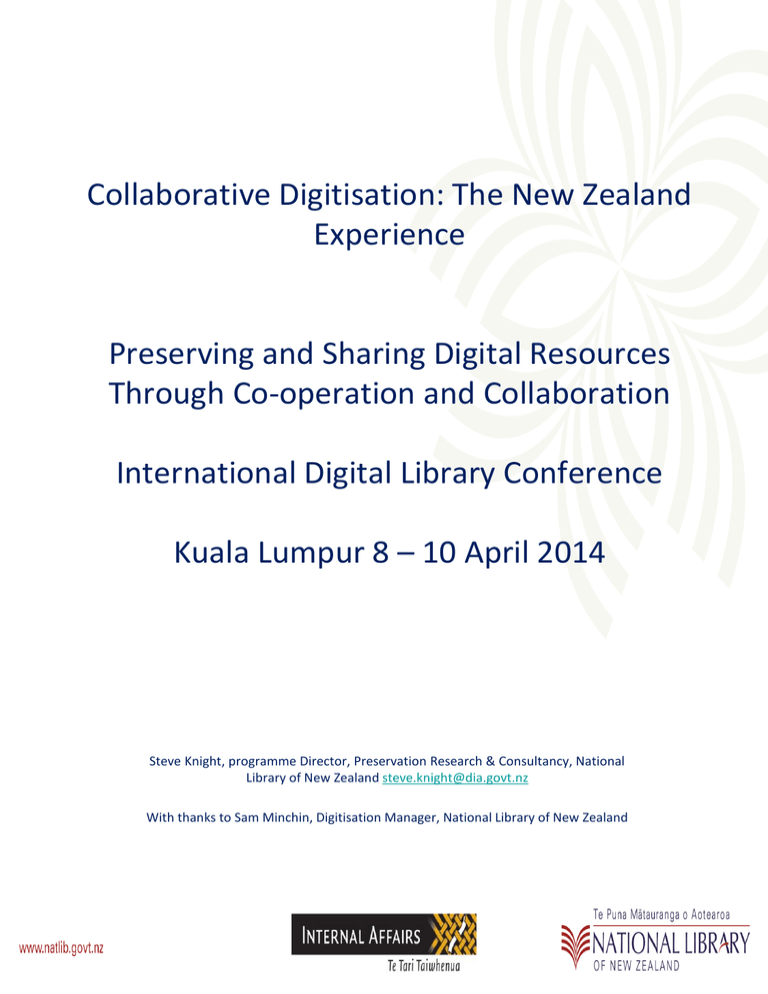
Collaborative Digitisation: The New Zealand Experience Preserving and Sharing Digital Resources Through Co-operation and Collaboration International Digital Library Conference Kuala Lumpur 8 – 10 April 2014 Steve Knight, programme Director, Preservation Research & Consultancy, National Library of New Zealand steve.knight@dia.govt.nz With thanks to Sam Minchin, Digitisation Manager, National Library of New Zealand National Library of New Zealand Combined with Department of Internal Affairs in 2011 Archives New Zealand and Government Information Services DIA provides a wide range of services, eg births/deaths/marriages, passports, community grants, anti-spam and gambling National Library Act 2003 Purpose is to enrich the cultural and economic life of NZ by Collecting, preserving and protecting documents … and making them accessible for all the people of NZ Supplementing and furthering the work of other libraries in NZ Working collaboratively with other institutions having similar purposes So NLNZ has a statutory obligation to act in collaboration Strategic Background Result Area 10 - Better public service – New Zealanders can complete their transactions with Government easily in the digital environment AOG ICT Strategy – (CE is also GCIO) - Services are digital by default, Information is managed as an asset, Investment and capability are shared Department of Internal Affairs – four areas of strategic focus including ‘Increased trust in how government manages New Zealand’s civic information’ which covers the National Library’s work in digitisation and digital preservation Information and Knowledge Services – Tipping Point – Digital Shift: transition from analogue to digital National Library – collect, connect and co-create knowledge to power New Zealand Strategic Partnership – 10 year programme of NLNZ and Archives NZ delivering shared outcomes where alignment allows Our strategic environment is focusing on developing digital services, understanding and leading the ‘digital shift’ and, as always, doing more with less National Library Digitisation Digitisation Strategy - 3 areas of focus •access (greater access to collections, enable use in new ways) •Preservation (at risk collection items, shifting to digital and managing for long term safekeeping) •collection building (focus on NZ and Pacific content, collaboration to build critical mass of New Zealand content) Two main streams of work Imaging Services – high quality in-house team Digitisation Team – large-scale projects Target of 450,000+ pages a year Newspapers, books, maps, parliamentary papers Increasing focus on collaboration to meet targets and deliver on strategy What is collaboration? Collaboration is the National Library of New Zealand working with others to create value by making important historic information available online By working together the National Library of New Zealand and collaborators can deliver more digitised content and better reflect New Zealand’s diverse customer needs Principles of collaboration Open access Acknowledgement Sustainable stewardship Fairness and transparency Principles of collaboration Open Access The key driver for this programme is access: giving New Zealanders ready access to historic newspapers, introducing the newspapers to new audiences, and enabling new ways to access and analyse our combined newspaper collections. Acknowledgment Collaborators who make financial and in-kind contributions will be acknowledged on the Papers Past website. For our partners this is critical as they need to be able to demonstrate to their funders on the value of their contribution. Principles of collaboration Sustainable stewardship The Papers Past website includes more than 80 newspaper titles, and we expect this to grow over time. To manage this collection efficiently the National Library must have consistency in the way that we work, and consistency in the way that we work with our collaborators. Fairness and transparency The National Library will undertake our collaborative work in a transparent and fair manner. NLNZ welcomes feedback and comment from those included in the programme (or interested parties). That information will be used to improve the programme to make sure that as many groups and communities can be included and are happy with the outcomes. Opportunity for groups of all sizes to become involved. Collaboration in action Why collaborate (benefits) Increase range of content Access to more content from a wider range of institutions Filling in our collection gaps Leveraging other major collections Development of a National Collection Do more together Combined budgets deliver more content Greater pool of funds allows better arrangements with suppliers Minimise duplication Effort, content and digitisation platforms Some more benefits... Utilise expertise (wherever it is) Others plug into the NL workflow and tools Individual institutions can focus on what they’re good at Shifts the focus to outcomes rather than “how do I?” Increased Engagement Community buy-in Enhanced reputation Greater participation Greater use of the digitisation outcomes First year of formal digitisation agreements 12 partners – contributions ranging from $10,000+ to a few hundred $ First year of collaborative newspaper programme 14 partners at the beginning, 3 still continuing 10 partners, 7 continuing To June 2014 16 formal partnerships, 8 continuing Includes 1st agreement with a private individual Growth in collaboration Focus on new formats But it isn’t all plain sailing… Collaboration takes time…longer than you think… Sustainable stewardship requires formal agreements How we work together, agreeing deliverables and timeframes Ownership of the digitised data? What can the parties do with the digitised data? Prioritisation Balance between National Library priorities and those of the collaborative partner Stakeholder management Need to engage fully with partners Meeting all partners’ needs Case Studies Appendices to the Journals of the House of Representatives (AJHR) Newspapers Maps Appendices to the Journals of the House of Representatives (AJHR) Government-related reports tabled in Parliament Goal - vital records available to the public in an easily accessible and searchable form. Scope 1854-1999 – already available online from 2000 Current coverage – launched in 2010, complete to 1950, approx 320,000 pages National Library lead Endorsed and with permission from Clerk of the House Utilisation of expertise around New Zealand Subject expert and technical stakeholder groups Governance via a cross-sector steering group (Office of the Clerk, Parliamentary Library, legal sector, universities and public libraries) Funded from wide range of sources contributions range from 50k to $100s. Content sourced from multiple organisations (destructive scanning) Newspapers – Papers Past Papers Past started life in 2001 with digital images of selected 19th century newspapers and periodicals. In 2007 it was re-launched with the current look and feel and more importantly, searchable text. Papers Past has had a strong impact on the way New Zealanders conduct research. Communities throughout the country now have easy access to information that previously was only available at their local library. It also gives us whole new insights into New Zealand’s history and the lives of New Zealanders. Types of newspaper collaboration Collaborative Programme Partnerships Small Big Single year Multi-year Community-driven Selection process Groups of all sizes Large institutions National Library expertise Shared expertise No one size fits all We need to adapt our programmes to meet customer needs Maps Partnership University of Auckland Digitise complete set of NZ government maps 20,000 maps 600 dpi (for research and academic use and enabling geo-tagging) Catalogue records Digital preservation ½ way through 3 year partnership Utilise UoA expertise Leveraging University of Auckland expertise In many ways the relationship with the partner here is like that of client / vendor. UoA provide staff and equipment to digitise the maps to agreed specifications. The library then catalogues and loads maps into the National Digital Heritage Archive. The maps are then available online and the digital copies preserved. From here the relationship changes and UoA becomes the expert and they begin adding extra value to the digitised content. They take the metadata (catalogue records), format into a GeoNetwork standard, encode the TIFFs with geo-references and load them into the GeoDataHub. The maps will also be available through the GeoDataHub with enhanced access. The GeoDataHub will provide enhanced access to the map data (compared to the library catalogue records). Where to next? Build on success of current collaboration Keep working with partners to improve how we work together Profile New Zealand content digitised elsewhere Google Books, HathiTrust etc What is the quality of the digitised content How to free up access to this content (much of this material is currently blocked to New Zealand internet users) Work with copyright holders, re-digitise? Opening up access to datasets created through digitisation (eg interrogation of 3 million pages of Papers Past as a data set, computational linguistics etc) Review Digitisation Strategy Confirming digitisation goals So, why Co-operation in Libraries? Building and providing access to national collections Collecting content from throughout New Zealand Bringing together online as single collection or views within multiple collections Delivering a joined-up approach to digitisation Focus on doing rather than “how do I?” Lowers the bar to enable a wider range of other organisations to participate in digitisation projects (smaller institutions, individual citizens) Everyone has a way of participating and enabling access Utilise expertise – wherever it resides Increased value for money (eg single procurement processes and digitisation platforms) And, at the very least, we are fulfilling our statutory purpose One last thing - how do we ensure long term preservation of our digital collections? NLNZ Draft Digitisation Strategy Goal 4 – Ensure the long term access to New Zealand content through digitisation for preservation and digital preservation Focus for Goal 4 At-risk collections are digitised and preserved for future generations All materials included in the digitisation programme are preserved in the NDHA We need to provide confidence in the integrity and authenticity of our digital collections to our users of the future. Questions? Digitisation strategy http://natlib.govt.nz/about-us/strategy-andpolicy Collaborative digitisation http://natlib.govt.nz/librarians/nationallibrary-services/collaborative-digitisation AJHRs http://atojs.natlib.govt.nz Papers Past http://paperspast.natlib.govt.nz Sam Minchin, Manager Digitisation, National Library of New Zealand sam.minchin@dia.govt.nz
